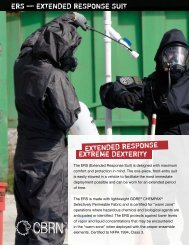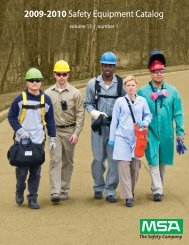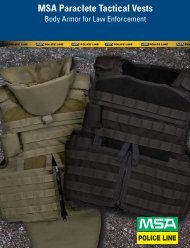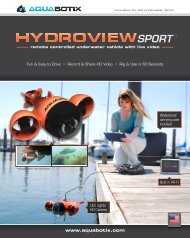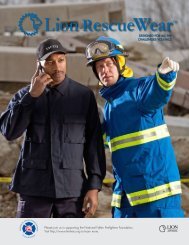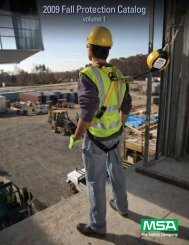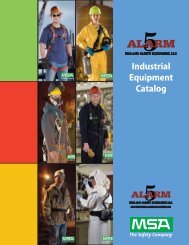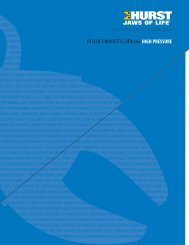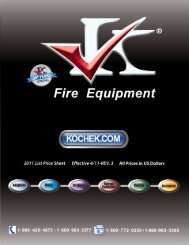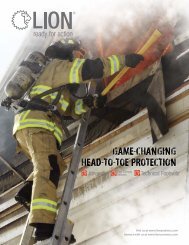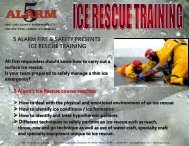EQUIPMENT FOR RESCUE aNd wORk aT hEIghT - 5 Alarm Fire ...
EQUIPMENT FOR RESCUE aNd wORk aT hEIghT - 5 Alarm Fire ...
EQUIPMENT FOR RESCUE aNd wORk aT hEIghT - 5 Alarm Fire ...
- No tags were found...
Create successful ePaper yourself
Turn your PDF publications into a flip-book with our unique Google optimized e-Paper software.
48www.cmcrescue.comWhat is 3σ MBS?You might think that answering the question “how strong is my carabiner?”would be relatively easy. But even with modern, high-tech alloys, twoidentical carabiners will break at slightly different forces. So, breaking the fivesamples called for by the NFPA test method will provide five different results.If the average breaking strength is reported, the odds that your carabiner isweaker than the average are about one in two. Even if the strength of theweakest sample is reported, there is still the possibility that your carabinercould be weaker, and there is no way to know how much weaker. The industrysolution is to use a statistical formula, referred to as Three Sigma (3σ), whichprovides a 99.87% level of confidence that the strength of your carabiner willmeet or exceed the reported MBS.NFPA 1983 specifies a minimum performance standard for rescue equipment.For example, a General Use carabiner must have a 3σ minimum breakingstrength (MBS) of at least 40 kN (8,992 lbf). The standard allows themanufacturer to label the product with the MBS required by the standardor any higher number that is not more than the actual 3σ MBS calculatedfrom the test results of the five samples. Beginning in 2011, all CMC Rescueproducts compliant with NFPA 1983 will be marked with the actual 3σ MBSrounded down to the nearest kN. As always, CMC Rescue regularly submitsproducts to a third-party test lab (currently Underwriters Laboratories, UL) toensure that current production samples of compliant products continue tomeet the performance requirements of the standard.Carabiner Performance RequirementsLight Use “L”General Use “G”• Major Axis 3σ MBS of not less than 27 kN (6,069 lbf.)• Major Axis with gate open 3σ MBS of not less than7 kN (1,574 lbf.)• Minor Axis 3σ MBS of not less than 7 kN (1,574 lbf.)Pulley Performance RequirementsLight Use “L”• 3σ MBS of not less than 22 kN (4,946 lbf.)• 3σ MBS of a becket of not less than 12 kN (2,698 lbf.)• Minor Axis 3σ MBS of not less than 7 kN (1,574 lbf.)Descent Control & Rope Grab Performance RequirementsLight Use “L”General Use “G”• Rope grab devices must not show any permanentdamage to the device or to the rope at 50 kN(1,124 lbf.)• Descent control devices must not show anypermanent damage to the device or to the rope at5 kN (1,124 lbf.) and have a 3σ MBS of not lessthan 13.5 kN (3,034 lbf.)• If the descent control device has a passive breakingfeature, the device shall not slip more than 25mm at a force of 1.35 kN (300 lbf.)• Major Axis 3σ MBS of not less than 40 kN (8,992 lbf.)• Major Axis with gate open 3σ MBS of not less than11 kN (2,473 lbf.)• Minor Axis 3σ MBS of not less than 11 kN (2,473 lbf.)General Use “G”• 3σ MBS of not less than 36 kN (8,093 lbf.)• 3σ MBS of a becket of not less than 19.5 kN (4,383 lbf.)• Minor Axis 3σ MBS of not less than 11 kN (2,473 lbf.)• Rope grab devices must not show any permanentdamage to the device or to the rope at 11 kN(2,500 lbf.)• Descent control devices must not show anypermanent damage to the device or to the rope at5 kN (1,124 lbf.) and have a 3σ MBS of not lessthan 22 kN (4,946 lbf.)• If the descent control device has a passive breakingfeature, the device shall not slip more than 25mm at a force of 2.7 kN (600 lbf.)NFPA 1983 does not have a specific category for belay devices. Depending on how the device functions,it is tested to either the Rope Grab or Descent Control Device performance requirements.ProSeries ®PulleysBasic Building Blocksof Most Rescue SystemsUL Classified to NFPA 1983 – General UseEN 12278No detail has been overlooked in these high-efficiency pulleys.These compound or complex system workhorses featureprecision sealed ball bearings to minimize loss of mechanicaladvantage. The large carabiner hole supports multiple carabiners,and the smooth, rounded edges on the high-strength aluminumside plates minimize rope fraying. The bottom is shaped formaximum efficiency with Prusik hitches but also works wellwith Gibbs-type ascenders. Large anodized aluminum sheavesprovide efficiency, and low-profile axle fasteners reduce snagswhen the pulley is moving.300441ProSeries Pulleys | hardware 49Item # Type Color NFPA Rating 3σ MBS Sheave Tread Size Weight Price300441 Single Blue General Use 43 kN (9,666 lbf.) 2-1/4 x 1/2 in. (57 x 13 mm) 12 oz. (340 g) $85.00300442 Double Gold General Use 62 kN (13,938 lbf.) 2-1/4 x 1/2 in. (57 x 13 mm) 1 lb. 5 oz. (595 g) $115.00300461* Single Red General Use 76 kN (17,085 lbf.) 3-3/4 x 1/2 in. (95 x 13 mm) 1 lb. 14 oz. (850 g) $110.00*Item #300461 is not CE certified300442Anodized aluminum sheavehas a full 2-1/4-inch tread diameterRoundededgeson high-strengthaluminum sideplatesBottom shapedfor maximumefficiency withPrusik hitches300461*Sealed ballbearingfor highefficiencyLow-profile hardwareminimizes snagging onground or componentscmc rescue | 800-235-5741 | 805-562-9120Personal Gear Auxiliary Equipment Patient Care & Transport Systems & Kits Bags & Packs Anchor Devices Rope & Web Hardware Harnesses



